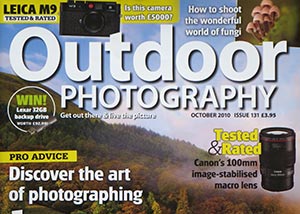Since the publication of Landscape Painting, many photographers have commented on how helpful they found the guidelines on site selection and composition. A recent book review in Outdoor Photography wrote, “Just as they [painters]have to struggle to discern light, form and composition, then photographers, too, have to work with the same basic ingredients in order to come up with a compelling image.” Read the complete review below.
I cover these “basic ingredients” in Chapter 6, Site Selection, and Chapter 7, Composition. In brief, they are: differentiation, the ability to differentiate colors, values, and shapes from another; spatial cues such as patterns of light and shadow (which suggest volume), scale, overlap and perspective; and composing through the picture window. Poor photographs — lacking these essential cues — always make for poor reference.
Also see The Landscape Painter’s Guide to Selecting Reference Photos.
Painters need to be careful, though. Photographs can fool us. They present a type of realism which we readily accept as a close stand-in for reality. So it becomes easy to overlook things like flatness and ambiguity. A particular photograph might work really well on its own terms, but will give the painter trouble because of its lack of differentiation and spatial cues. In other words, you can get away with things in a photo that you can’t in a painting.
 Full review:
Full review:
What? A landscape painting book in a nature photography magazine! There are probably few of us who regularly delve into painting literature in search of inspiration for our photography techniques, but the obvious parallels between the two disciplines means that photographers can learn a great deal from brush-wielding artists. Just as they have to struggle to discern light, form and composition, then photographers, too, have to work with the same basic ingredients in order to come up with a compelling image. In this beautifully designed, clearly written a book, Albala (who has been teaching landscape painting for over 20 years) takes us through the fundamentals of the painting process, from selecting a good site in perspective, and the secrets of good composition, to how to best use light and color. Of course, this is all done from a the painter’s viewpoint but I would be surprised if there was any outdoor photographer out there who would not gain some fresh insight from glimpsing the world from behind an easel. – Steve Watkins, Editor, Outdoor Photography, October 2010
Additional Resources
Landscape Painting: Essential Concepts and Techniques for Plein Air and Studio Practice
Chapter 6 – Site Selection
Chapter 7 – Composition
Chapter 10, Working with Photographs
The Landscape Painter’s Guide to Selecting Reference Photos
Evaluating Photo Reference for a Series

2 Comments
Congratulations! Being reviewed by Outdoor Photography is a big deal. But he’s right, your book is excellent. Allow me to give a brief commercial and say, that while your book is great, getting into your landscape painting class really helped me apply what I had read. The exercises you gave to us pulling material from photos is extremely valuable. (just so you know, that doesn’t mean I “enjoyed” painting in black and white acrylic!)
MItchell, I just bought your book two weeks ago and have devoured every word! It’s well written and as a landscape oil painter of 10+ years, I know most of what’s in your book! But because it’s so well organized it will be my handy guide from now on … never to replace Richard Schmid’s Alla Prima, but a great companion guide.
I have many art books in my library of course but yours is very specific for both the beginner and professional! I always take photos of the places I pleinair paint but know that these are for reference only; they do not have the same artistic quality as a great painting can have! It’s that lagniappe, that something extra that an painter can represent in their work, a bit of themselves I suppose! It would be smart for photographers to take the hint and read how painters can use color to create a landscape!